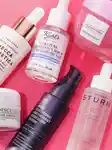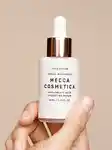This hydrating hero is like a big drink of H2O for your complexion; a moisture magnet that attracts water to the skin and holds it there. While dull, dry, dehydrated skin in dire need of drink will undoubtedly benefit from this hydration-boosting ingredient, hyaluronic acid can be used at any time for a natural, beaming glow.
Here, MECCAversity Category Strategy Manager, Lucy, explains why hyaluronic acid should be in everyone’s routine, regardless of your skin type.
What is hyaluronic acid?
Put simply, it’s a water-loving molecule – also known as a humectant. Humectants are masters at attracting and binding water (think: humidity); probably one of the most popular facts about hyaluronic acid is its ability to hold 1,000 times its own weight in water – impressive! This means it not only keeps water content within the skin, but when it expands the result is skin that’s plump and smooth.
According to Shaw, our skin is pretty clever, producing its own hyaluronic acid to bind moisture and create lubrication – particularly around joints, in the skin and eyes.
“As our skin knows and recognises hyaluronic acid, it’s very compatible, which means it won’t shock or irritate your skin – and it’ll be put to good use,” explains Shaw.

What can I pair with hyaluronic acid?
Great news – hyaluronic acid is friends with just about every product in your beauty cabinet. But there are a few standout ingredients that, when coupled with hyaluronic acid, will supercharge your results.
First up, Shaw suggests pairing hyaluronic acid with lactic acid: “Lactic acid is similar in that it is water-binding, plus it exfoliates the skin for a refined complexion. If you’re oily or acne prone, don’t starve your skin of hydration and moisture; all skin types require hydration and everyone can use hyaluronic acid.”
Retinol, while notoriously fussy, is another ingredient that has serious chemistry with hyaluronic acid. But! A few things to keep in mind: retinol before hyaluronic; give your retinol some time to sink right in; and use this pairing in the PM only (generally speaking, most retinol products should be used in the evening).


Which skin types can use hyaluronic acid?
All skin types can use hyaluronic acid, especially if you’re more on the sensitive side: “Hyaluronic acid is ideal for somebody with sensitive skin as it will help to prevent transepidermal water loss (TEWL) and therefore strengthen a sensitive skin barrier,” says Shaw.
The most important thing to keep in mind with sensitive skin is that its barrier is compromised, so it’s important to supplement not only water and water-binding ingredients, but also lipids and oils. The latter two help to reinforce the barrier and create a protective watertight seal.
However, everyone’s skin is different so it is still important to patch-test your hyaluronic acid products before use.
The benefits of hyaluronic acid (and why you should apply it to damp skin)
You might’ve come across the odd ‘sticky’ hyaluronic acid – this quality is also why it can so easily ‘grab onto’ water. However, choosing a hyaluronic serum over a moisturiser means it has a better chance of absorbing into your skin, and you can apply another product on top to help counteract that ‘tacky’ feeling.
“The most important thing when it comes to applying hyaluronic acid is ensuring that you don’t apply it to dry skin, as it may sit on the surface and have a reverse effect and draw moisture out,” explains Shaw.
“Make sure the skin is damp by applying an essence, toner or mist first, then follow with your hyaluronic acid serum; this’ll boost its hydrating benefits and trap this moisture for long-lasting hydration,” she adds.












